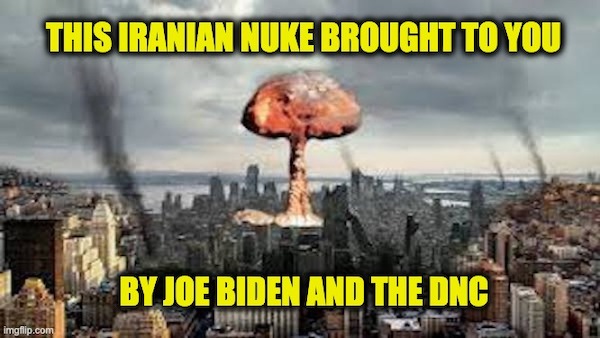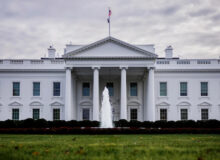The 2020 Draft Democratic Party Platform puts the Sunni Muslim States, Israel, and the United States in existential danger because of the promise to put the United States back into the Iran Nuclear Deal (JCPOA), which President Trump correctly pulled the country out of in 2018. DNC allows Iran nuclear
Specifically, a paragraph on page 79 of the platform reads:
We believe the Joint Comprehensive Plan of Action (JCPOA) remains the best means to verifiably cut off all of Iran’s pathways to a nuclear bomb. The Trump Administration’s unilateral withdrawal from the JCPOA isolated us from our allies and opened the door for Iran to resume its march toward a nuclear weapons capacity that the JCPOA had stopped. That’s why returning to mutual compliance with the agreement is so urgent. The nuclear deal was always meant to be the beginning, not the end, of our diplomacy with Iran. Democrats support a comprehensive diplomatic effort to extend constraints on Iran’s nuclear program and address Iran’s other threatening activities, including its regional aggression, ballistic missile program, and domestic repression.
Returning to the deal that President Trump correctly pulled the country out of, gives Iran free reign to go nuclear in at least three ways:
- The JCPOA has vital provisions that expire in 2025 and 2030.
- Much of what we were told about the JCPOA by the Obama/Biden Administration were lies, or they allowed Iran to get out of requirements without telling the public.
- As far as Iran following the provisions of the agreement, as you will find out later in this post—it ain’t very pretty.
Below are the details:
Obama Lied about anytime-anywhere inspections. Because of a secret side deal revealed by the Associated Press long before the deal was agreed to, Iran gets to self-inspect the Parchin military base with no IAEA inspectors present. Parchin is the site where Iran was working on nuclear triggers for its bomb program. Therefore there is no real way to know if Iran is violating the JCPOA at Parchin.
All other military base inspections are allowed under the JCPOA. The agreement specifically “requests the Director-General of the IAEA to undertake the necessary verification and monitoring of Iran’s nuclear-related commitments for the full duration of those commitments under the JCPOA.” Despite what the JCPOA states, the Iranian authorities claim military sites are off-limits to the IAEA. Sadly the IAEA and the countries that stayed in the deal refuse to push the point because they didn’t want Iran to seem non-compliant, even though they were non-compliant.
One of the problems with the Iranian authority’s refusal involves “Section T” of the deal. In Aug. 2017, the IAEA’s announced that it had been unable to verify a vital part of the JCPOA known as “Section T.” That section lists, “Activities which could contribute to the design and development of a nuclear explosive device.” Their refusal to allow inspections doesn’t mean Iran violated “Section T.” It means is your guess is as good as mine, because nobody knows — but the deal says the IAEA is supposed to inspect.
The promised sanction “snap-backs” don’t really exist. President Obama gave Europe, China, and Russia written promises. He wrote that the U.S. guarantees any of their companies who make deals with Iran, would not have to stop working with Iran should sanction need to be re-imposed should Iran get caught violating the JCPOA.
Kerry said it was a forever deal, he lied: The agreement allows Iran to go nuclear after ten years. Do you remember when John Kerry insisted the Iran nuclear deal was a “forever deal?” That was a lie. Some of the provisions expire after year 10, and the rest of them after year 15. Based on the agreement, by the end of year 15, Iran could have in place a nuclear infrastructure that could produce significant quantities of weapon-grade needed to create a few nuclear weapons within months.
Kerry Lied About Ballistic Missiles: The JCPOA lifted the ban on the Iranian ballistic missile program. Before the deal U.N. Security Council Resolution (UNSC) 1929, the council used mandatory language about ballistic missiles, it said, “It decides that Iran shall not undertake any activity related to ballistic missiles capable of delivering nuclear weapons.” The P5+1 resolution passed by the UNSC changes the language. On page 119 of the UNSC approved deal does not prohibit from carrying out ballistic missile work but asks them nicely not to carry out ballistic missile development. The resolution merely says, quote, “Iran is called upon not to undertake such activity.”
The issue of the changed language was raised at a July 2015 Senate Foreign Relations Committee hearing. Secretary of State Kerry was there trying to sell the agreement. He was questioned by Sen. Menendez about the change in wording. The ensuing conversation suggests Kerry was lying, totally clueless, or both. Menendez kept reading out loud from the old and new resolutions, switching from “shall not” to “called upon not to,” while Kerry kept insisting that the different words were precisely the same.
Iran broke the terms of the heavy water provisions of the deal twice in 2016, but Obama let them “off the hook.”
The JCPOA Reduced Iran’s Reporting requirements: The Iran nuclear deal significantly reduces the reporting requirements about Iran’s nuclear program that existed before. That is, according to IAEA Director General Yukiya Amano, the former head of the international inspection group International Atomic Energy Agency. Iran threatened Mr. Amano with harm if he reveals anything about the side deals.
Iran never reported to the IAEA Their nuclear History: Iran had been non-compliant with its obligation to reveal its atomic history. According to the JCPOA, the rogue nation was supposed to disclose its pre-deal nuclear program. This was a condition for implementing the agreement. The historical knowledge is necessary so the IAEA will know how, when, and where to inspect Iran’s program in the future. When it came time to “fess up,” Iran told the IAEA that it never had a nuclear program. The IAEA reported what it was told instead of pushing back against a blatant lie. This is another example of a breach of the accord that was published as compliance. In other words, the entire agreement was based on a lie and should never have been implemented.
Using information secretly gathered by a Mossad operation in Iran and verified by the United States, in April 2018, Israeli Prime Minister Binyamin Netanyahu exposed a significant lie in the information the Iranians supplied to the IAEA for its 2015 report. Iran not only had a nuclear weapons program (called Amad) but after it was supposedly canceled in 2013, the work continued.
In January 2020, Iran declared it will no longer abide by any of the restrictions imposed by the 2015 nuclear deal (JCPOA). But it doesn’t really matter. The JCPOA didn’t really restrict Iran, and Iran wasn’t observing essential parts of the agreement anyway.
Per The Institute For Science And International Security, a non-partisan organization that goes by the unfortunate acronym of ISIS, the IAEA found many Iranian violations of the JCPOA in November 2019 two months before Iran said it would no longer abide by the agreement. The main violations, some of which are not fully reversible, are highlighted below:
- The IAEA found natural uranium of “anthropogenic origin” at an undeclared site in Iran;
- Iran introduced uranium hexafluoride and started uranium enrichment at the Fordow Fuel Enrichment Plant (FFEP);
- Iran further increased its quantity of low enriched uranium above the JCPOA’s 300 kilogram (kg) cap (uranium hexafluoride mass), ramping up monthly production significantly;
- Iran continued to produce enriched uranium above the limit of 3.67 percent, producing at a level of up to 4.5 percent;
- Iran initiated the operation of many advanced centrifuges at the Natanz Pilot Fuel Enrichment Plant (PFEP) to accumulate enriched uranium;
- Iran increased the number and type of centrifuges enriching uranium above the limit of 5,060 IR-1 centrifuges. The total separative work involved in uranium enrichment has grown from an estimated 4,550 to 6,200 separative work units (SWU) per year, a 36 percent increase over the enrichment capacity allowed by the JCPOA;
- Iran withdrew advanced centrifuges from storage for installation at the PFEP. It reinstalled a cascade of 164 IR-4 centrifuges and one of 164 IR-2m centrifuges in the PFEP and initiated the collection of enriched uranium;
- Iran installed and operated several new advanced centrifuge types at the PFEP not listed as permitted for installation in the nuclear deal;
- Iran enriched uranium in a cascade of 30 IR-6 centrifuges at the PFEP and initiated the installation of a total of 164 IR-6 centrifuges that would accumulate enriched uranium;
- For twelve days, Iran conducted mechanical testing of three IR-4 centrifuges simultaneously at the Tehran Research Center;
- Iran “prepared a new location,” beyond those specified in the JCPOA and unidentified in the report, for mechanical testing of centrifuges;
- Iran used declared centrifuge manufacturing equipment for activities beyond those specified in the JCPOA, such as for producing centrifuges in type or number not allowed by the JCPOA;
- Iran continued to use carbon fiber in making rotor tubes that were not subject to continuous IAEA containment and surveillance measures, in violation of conditions in the JCPOA and a January 14, 2016, Joint Commission implementing decision on how rotor tubes would be manufactured with materials such as carbon fiber that must be taken from a designated storage location under IAEA monitoring. This case implies that Iran’s nuclear program had hidden stocks of carbon fiber or had acquired it from abroad or from another Iranian entity without subjecting the carbon fiber to the rules established on storing it under IAEA monitoring before its use in manufacturing rotor tubes. (Any such carbon fiber was likely obtained via illicit procurement from abroad);
- As described by U.S. authorities, Iran may be violating the JCPOA’s procurement restrictions by illicitly importing nuclear dual-use equipment.
The provision places many of Iran’s neighbors in grave danger, including the Sunni Muslim countries and Israel. Iran has promised to destroy them. What most Americans forget is that Iran calls Israel the little Satan and the United States the big Satan. In other words, along with many other parts of Joe Biden’s platform, this plank puts the United States in grave danger.
DNC allows Iran nuclear, DNC allows Iran nuclear, DNC allows Iran nuclear, DNC allows Iran nuclear.






